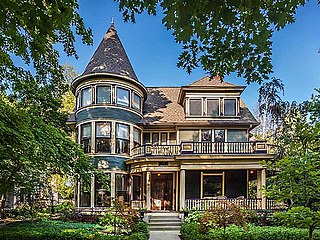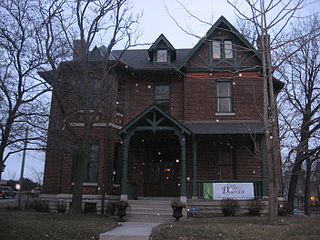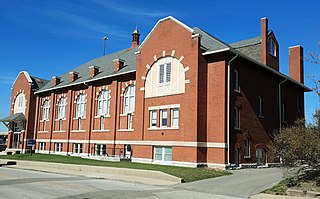Indianapolis has seven designated neighborhoods as Cultural Districts, first established in 1999: Broad Ripple Village; Mass Ave; Fountain Square; Wholesale District; Canal and White River State Park; Indiana Avenue; and Market East. The purpose of these designations was to capitalize on cultural institutions within historically significant neighborhoods unique to the city's heritage for economic development and revitalization.

Woodruff Place is a neighborhood in Indianapolis located about a mile east of Downtown Indianapolis. It was established in the 1870s by developer James O. Woodruff as an early suburb of Indianapolis. Woodruff Place's boundaries are: 10th Street on the north, Woodruff Place West Drive on the west, Michigan Street on the south, and Woodruff Place East Drive on the east. This community was an independent municipality and maintained autonomy, even as the City of Indianapolis grew and expanded around the neighborhood, enclosing the community well within the city limits. Woodruff Place was incorporated in 1876 and remained an independent town until 1962 when it became one of the final municipalities to be annexed by the City of Indianapolis prior to the merger of city and county governments in 1969.

Fountain Square is one of seven designated cultural districts in Indianapolis, Indiana. Located just outside the city's downtown district, Fountain Square is home to three designated national historic districts, the Laurel and Prospect, the State and Prospect, and the Virginia Avenue districts, all of which were listed on the National Register of Historic Places in 1983. The neighborhood derives its name from the successive fountains that have been prominently featured at the intersection of Virginia Avenue, East Prospect Street, and Shelby Street.
The Bates–Hendricks neighborhood is situated just south and east of the downtown commercial district of Indianapolis, Indiana. The Fountain Square business district is just to the east.

Herron–Morton Place is a historic district in Indianapolis, Indiana, United States. The boundaries of the neighborhood are East 16th Street on the south, East 22nd Street on the north, North Pennsylvania Street on the west, and Central Avenue on the east.

Lockerbie Square Historic District is a national historic district on the National Register of Historic Places within Indianapolis, Indiana, listed on February 23, 1973, with a boundary increase on July 28, 1987. It is noted for its Federal, Italianate, and Queen Anne style architecture. The original platting of Lockerbie Square, done by Jannett Smith Lockerbie McOuat and named for her father, Scottish immigrant George Murray Lockerbie, was between 1847 and 1850. The 1960s saw an immense effort to save the buildings within the district, becoming the first historic district in Indianapolis. Many of the buildings date from 1855 to 1930. James Whitcomb Riley, famed Hoosier poet, lived in the district for over two decades. He was known to give candy to local children on his regular walks.

Old Northside is a residential neighborhood near downtown in Indianapolis, Indiana. It is bordered by 16th Street on the north, Pennsylvania Street on the west, Interstate I-65 on the south, and Bellefontaine Street on the east. The Monon Trail runs along the eastern edge of The Frank and Judy O'Bannon Old Northside Soccer Park.

The North Irvington Gardens Historic District is a neighborhood and national historic district in Indianapolis, Indiana. It was placed on the National Register of Historic Places on June 27, 2008. It is immediately to the north of the Irvington Historic District, which has been on the National Register since 1987, sharing the same east and west boundaries of the older district, and extending north to 10th and 11th streets. It is a neighborhood of mostly residential buildings dating primarily from 1910 to 1950, with no one distinctive architectural style, including a house associated with the historic Osborn Farm. Except for one church, the only buildings contributing to the historic nature of the district are 843 houses and 551 garages. Most fences in the district mark the perimeter of the individual properties; very few are along the streets.

The Washington Park Historic District is a national historic district located in Indianapolis, Indiana. It was listed on the National Register of Historic Places on June 24, 2008. It comprises nearly 60 acres (240,000 m2) and is located 4 miles (6.4 km) north of downtown Indianapolis, in the south-central part of the Meridian-Kessler neighborhood. The district includes all properties south of 43rd Street and north of 40th Street, and west of Central Avenue and east of the alley running north and south between Pennsylvania and Meridian Streets; Washington Boulevard runs north-south through the center of the district. It includes 110 contributing buildings, ranging mostly from mansions to small bungalows, and three non-contributing buildings.

The Athenæum, originally named Das Deutsche Haus, is the most ornate and best-preserved building affiliated with the German American community of Indianapolis. Once used as a German American Turnverein and clubhouse, it currently houses many groups, organizations, and businesses. The Athenæum is located across Massachusetts Avenue from the Old National Centre. It was placed on the National Register of Historic Places on February 21, 1973. On October 31, 2016, it was named the 41st National Historic Landmark in Indiana.

Vonnegut & Bohn was an architectural firm in Indianapolis, Indiana in the United States.
Kurt Vonnegut Sr. was an American architect and architectural lecturer active in early- to mid-twentieth-century Indianapolis, Indiana. A member of the American Institute of Architects, he was partner in the firms of Vonnegut & Bohn, Vonnegut, Bohn & Mueller, and Vonnegut, Wright, and Yeager. He designed several churches, banks, and became the in-house architect for Indiana Bell and Hooks Drug stores, practicing extensively in the Art Deco style. He was the father of chemist Bernard Vonnegut and author Kurt Vonnegut Jr.

Bernard Vonnegut I, WAA, FAIA, was an American lecturer and architect active in late-nineteenth and early-twentieth-century Indiana. He was a co-founder of the locally renowned Indianapolis architectural firm of Vonnegut and Bohn, and was active in a range of residential, religious, institutional, civic, and commercial commissions. He is the namesake and grandfather of scientist Bernard Vonnegut, father of the architect Kurt Vonnegut Sr., and grandfather of author Kurt Vonnegut.

Arthur Bohn, AIA, (1861–1948) was an American architect active from the 1880s to 1940s in Indiana. He was a co-founder of the Indianapolis architectural firm of Vonnegut and Bohn.

The Steele Dunning Historic District is a neighborhood and historic district in Bloomington, Indiana, United States. Composed of small, single- or double-family houses, the district includes houses built from the late nineteenth century through the middle of the twentieth century.

The Vinegar Hill Historic District is a historic district and neighborhood in Bloomington, Indiana, United States. Built primarily in the second quarter of the twentieth century, and located a few blocks south of Indiana University Bloomington campus, Vinegar Hill has been the home of leading Indiana University faculty members. It has inspired literary attention, and it has been designated a historic site.

Oliver Johnson's Woods is a historic district and neighborhood on the northern side of Indianapolis, Indiana, United States. Located in southern Washington Township, the district occupies the site of what was once the family farm of Oliver Johnson. Born on the present site of the Indiana State Fairgrounds, Johnson grew up in a pioneer family that lived on the edge of the state capital city. Upon attaining adulthood, he bought property a short distance to the west, to which he moved in 1846. Here, he built a larger farmhouse in 1862, and he tilled the soil for most of the rest of his life. As Indianapolis grew northward, it reached the Johnson farm in the early twentieth century; the aged farmer and his sons saw the city's growth as an opportunity for financial gain, and in 1905 they announced the platting of 0.25 square miles (0.65 km2) of their property into individual lots. They chose an advantageous time to sell their property; as the new residents began to build their homes, an interurban railway was built along College Avenue on the district's western side that connected downtown with Broad Ripple. Many prosperous businessmen were attracted by the development's large lots and wooded streets; the city annexed Oliver Johnson's Woods in 1912, and by the outbreak of World War II, the streets were filled with large houses built in a wide variety of architectural styles. These early residents came from many different ethnicities: European immigrants were becoming more prosperous and leaving their ethnic enclaves, and new neighborhoods such as Oliver Johnson's Woods appealed to them. Among the neighborhood's leading residents was a colony of Jews of German descent.

The Schnull–Rauch House, sometimes referred to as the Victorian Manor and now also branded as The Manor at The Children's Museum of Indianapolis, is a National Register of Historic Places-designated Romanesque Revival historic home constructed in the early 20th century at 3050 North Meridian Street, north of downtown Indianapolis, Indiana.

St. Joseph Neighborhood Historic District is a national historic district located at Indianapolis, Indiana. The district encompasses 57 contributing buildings in a predominantly residential section of Indianapolis. It was developed between about 1855 and 1930, and include representative examples of Italianate and Queen Anne style architecture. Located in the district are the separately listed Bals-Wocher House, William Buschmann Block, Delaware Court, Pearson Terrace, and The Spink. Other notable buildings include the Christian Place complex, Fishback-Vonnegut-New House, Henry Hilker House, Apollo-Aurora Rowhouses, Israel Traub Store, and Lorenzo Moody House.

South Side Turnverein Hall is a historic social club and gymnasium in the Bates-Hendricks neighborhood of Indianapolis, Indiana, affiliated with the city's German-American community. It was built in 1900 by prominent architects Vonnegut & Bohn, whose managing partners Bernard Vonnegut, Sr. and Arthur Bohn were members of the burgeoning German-American community in Indianapolis. The architects were also known for designing the Athenæum, another German-American social club in the city. The South Side Turnverein was an important gathering place for Indianapolis' south side German community until its decline in the 1940s. It was sold to investors in 1978 to be used as an athletic club.























